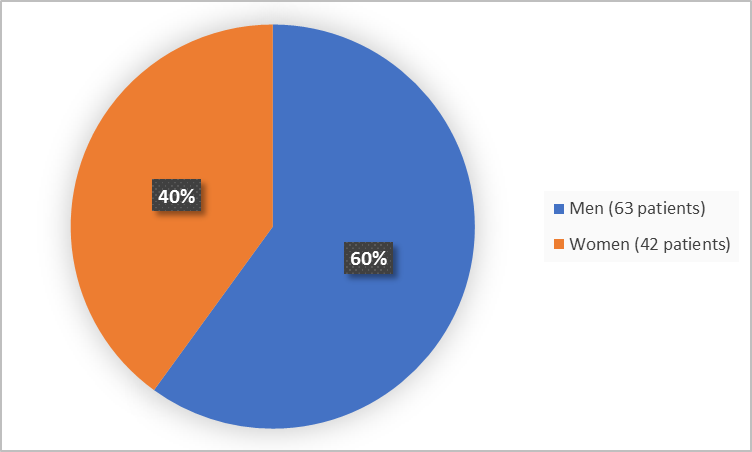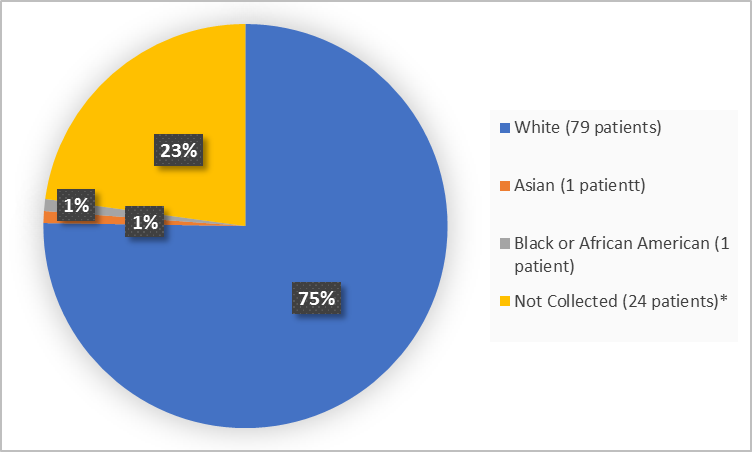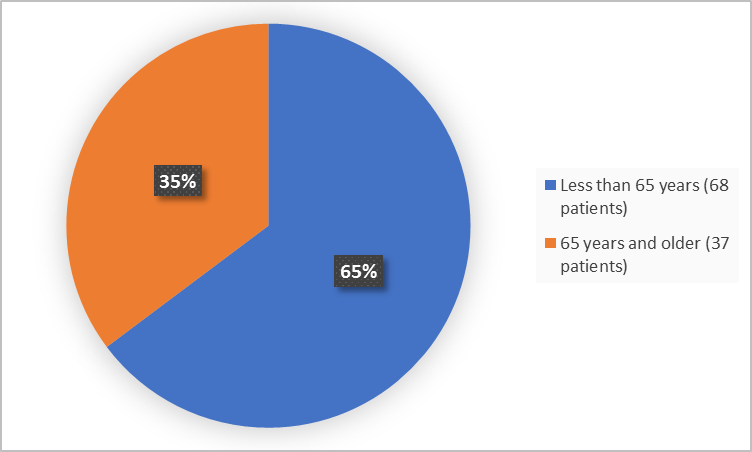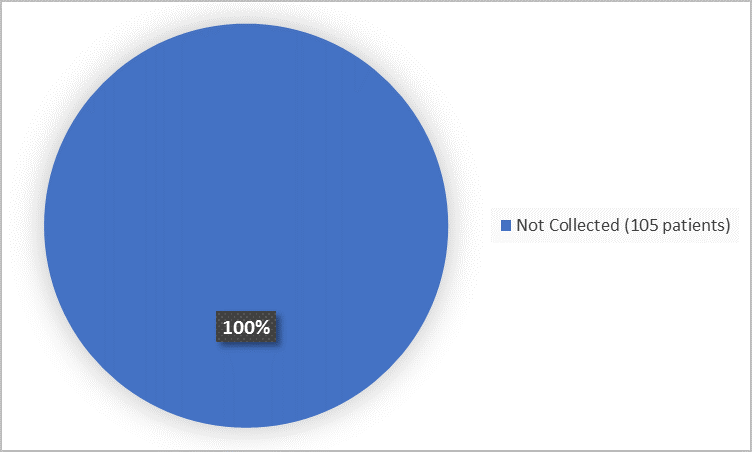Drug Trials Snapshots: ZEPZELCA
HOW TO USE THIS SNAPSHOT
The information provided in Snapshots highlights who participated in the clinical trials that supported the FDA approval of this drug, and whether there were differences among sex, race, and age groups. The “MORE INFO” bar shows more detailed, technical content for each section. The Snapshot is intended as one tool for consumers to use when discussing the risks and benefits of the drugs.
LIMITATIONS OF THIS SNAPSHOT:
Do not rely on Snapshots to make decisions regarding medical care. Always speak to your health provider about the risks and benefits of a drug. Refer to ZEPZELCA Prescribing Information for complete information.
ZEPZELCA (lurbinectedin)
zep zel' kah
Pharma Mar, S.A.
Approval date: June 15, 2020
DRUG TRIALS SNAPSHOT SUMMARY:
What is the drug for?
ZEPZELCA is a drug used to treat adult patients with small cell lung cancer (SCLC) which has spread to other parts of the body (metastatic) on or after treatment with platinum-containing therapy.
How is this drug used?
ZEPZELCA is given by a healthcare provider direcly into the vein (intravenous infusion) every three weeks. It takes about one hour to receive an infusion.
What are the benefits of this drug?
Thirty seven (35%) of 105 patients with SCLC who received ZEPZELCA experienced partial shrinkage of their tumors. Tumor shrinkage lasted more than 6 months for 35% of those patients.
ZEPZELCA was approved under FDA’s accelerated approval program, which provides earlier patient access to a promising new drug while the company continues to conduct clinical trials to confirm that the drug works well.
What are the benefits of this drug (results of trials used to assess efficacy)?
The table below summarizes efficacy results assessed by investigator in all patients and in platinum-resistant and platinum-sensitive subgroups.
Table 2. Efficacy Results in SCLC Patients
|
Investigator Assessed Response |
ZEPZELCA |
ZEPZELCA |
ZEPZELCA |
|
Overall Response Ratea (95% CI) |
35% (26%, 45%) |
22% (11%, 37%) |
45% (32%, 58%) |
|
Complete response |
0% |
0% |
0% |
|
Partial response |
35% |
22% |
45% |
|
Duration of Response |
|
|
|
|
Median in months (95% CI) |
5.3 (4.1, 6.4) |
4.7 (2.6, 5.6) |
6.2 (3.5, 7.3) |
|
% with ≥6 monthsb |
35% |
10% |
44% |
CI: confidence interval, CTFI: chemotherapy free interval
a Confirmed overall response rate
b Based on observed duration of response.
Adapted from ZEPZELCA Prescribing Information
Were there any differences in how well the drug worked in clinical trials among sex, race and age?
- Sex: ZEPZELCA worked similarly in men and women.
- Race: The majority of patients in the clinical trial were White. Differences in response to ZEPZELCA among races could not be determined.
- Age: ZEPZELCA worked similarly in patients younger and older than 65 years of age.
Were there any differences in how well the drug worked in clinical trials among sex, race, and age groups?
The table below summarizes overall response rate by sex and age subgroups. Race was not evaluated because of predominantly White population. Results should be interpreted with caution given the small sample size overall, and the limited number of patients in each subgroup.
Table 3. Subgroup Analyses Based on Overall Response Rate
|
Category Value |
Investigator Assessed ORR |
|||
|
Response n |
Total |
Overall Response Rate |
95% CI |
|
|
Sex |
|
|
|
|
|
Men |
24 |
63 |
38% |
(26%, 51%) |
|
Women |
13 |
42 |
31% |
(18%, 47%) |
|
Age Group |
|
|
|
|
|
<65 years |
22 |
68 |
32% |
(22%, 45%) |
|
≥65 years |
10 |
37 |
27% |
(14%, 44%) |
FDA Review
What are the possible side effects?
ZEPZELCA may cause serious side effects including decrease in blood cell counts because of bone marrow suppression, liver toxicity and harm to an unborn baby.
The most common side effects of ZEPZELCA are decreses blood cell counts, tiredness, increased creatinine, alanine aminotransferase, and glucose in blood, and nausea.
What are the possible side effects (results of trials used to assess safety)?
The table below summarizes adverse reactions that occurred in ≥10% of patients treated with ZEPZELCA.
Table 4. Adverse Reactions Occurring in ≥10% of Patients Treated with ZEPZELCA
|
Adverse Reaction |
ZEPZELCA |
|
|
All Gradesa,b (%) |
Grades 3-4 (%) |
|
|
General disorders |
|
|
|
Fatigue |
77 |
12 |
|
Pyrexia |
13 |
0 |
|
Chest pain |
10 |
0 |
|
Gastrointestinal disorders |
|
|
|
Nausea |
37 |
0 |
|
Constipation |
31 |
0 |
|
Vomiting |
22 |
0 |
|
Diarrhea |
20 |
4 |
|
Abdominal painc |
11 |
1 |
|
Musculoskeletal and connective tissue disorders |
|
|
|
Musculosceletal paind |
33 |
4 |
|
Metabolism and nutrition disorders |
|
|
|
Decreased appetite |
33 |
1 |
|
Respiratory, thoracic and mediastinal disorders |
|
|
|
Dyspnea |
31 |
6 |
|
Coughe |
20 |
0 |
|
Infections and infestations |
|
|
|
Respiratory tract infectionf |
18 |
5 |
|
Pneumoniag |
10 |
7 |
|
Nervous system disorders |
|
|
|
Peripheral neuropathyh |
11 |
0 |
|
Headache |
10 |
1 |
a Graded per NCI CTCAE 4.0
b No grade 5 adverse reactions were reported.
c Includes abdominal pain, abdominal pain upper and abdominal discomfort.
d Includes musculoskeletal pain, back pain, arthralgia, pain in extremity, musculoskeletal chest pain, neck pain, bone pain and myalgia.
e Includes cough and productive cough.
f Includes upper respiratory traction infection, viral upper respiratory tract infection, respiratory tract infection and bronchitis
g Includes pneumonia and lung infection.
h Includes neuropathy peripheral, neuralgia, paresthesia, peripheral sensory neuropathy, hypoesthesia, and hyperesthesia.
ZEPZELCA Prescribing Information
The table below summarizes laboratory abnormalities that occurred in ≥ 20% patients treated with ZEPZELCA.
Table 5. Laboratory Abnormalities (≥ 20%) Worsening from Baseline in Patients Receiving ZEPZELCA
|
Laboratory Abnormality |
ZEPZELCAa |
|
|
All Gradesb (%) |
Grades 3-4 (%) |
|
|
Hematology |
|
|
|
Decreased leukocytes |
79 |
29 |
|
Decreased lymphocytes |
79 |
43 |
|
Decreased hemoglobin |
74 |
10 |
|
Decreased neutrophils |
71 |
46 |
|
Decreased platelets |
37 |
7 |
|
Chemistry |
|
|
|
Increased creatinine |
69 |
0 |
|
Increased alanine aminotransferase |
66 |
4 |
|
Increased glucose |
52 |
5 |
|
Decreased albumin |
32 |
1 |
|
Decreased sodium |
31 |
7 |
|
Increased aspartate aminotransferase |
26 |
2 |
|
Decreased magnesium |
22 |
0 |
a The denominator used to calculate the rate varied from 95 to 105 based on the number of patients with a baseline value and at least one post-treatment value
b Graded per NCI CTCAE 4.0.
ZEPZELCA Prescribing Information
Were there any differences in side effects among sex, race and age?
- Sex: The occurrence of side effects was similar in men and women.
- Race: The majority patients in the clinical trial were White or Asian. Differences in side effects among races could not be determined.
- Age: The occurrence of serious side effects1 was higher in patients older than 65 years of age.
Were there any differences in side effects of the clinical trials among sex, race, and age groups?
Tables 6 and 7 summarize selected adverse reactions that occurred in the clinical trial by sex and age subgroups. Race was not evaluated because of predominantly White population.
Table 6. Selected Adverse Reactions by Sex
|
Adverse Reaction |
Men (N=63 ) |
Women (N=42) |
||
|
All Grades |
Grades 3-4 |
All Grades |
Grades 3-4 |
|
|
Overall |
98 |
59 |
98 |
55 |
|
Fatigue |
78 |
13 |
76 |
12 |
|
Nausea |
35 |
0 |
40 |
0 |
|
Febrile neutropenia |
8 |
8 |
0 |
0 |
Table 7. Selected Adverse Reactions by Age
|
Adverse Reactions |
<65 Years (N=68 ) |
≥65 Years (N=37) |
||
|
All Grades |
Grades 3-4 |
All Grades |
Grades 3-4 |
|
|
Overall |
97 |
49 |
100 |
73 |
|
Fatigue |
76 |
9 |
78 |
9 |
|
Nausea |
41 |
0 |
30 |
0 |
|
Febrile neutropenia |
2 |
2 |
11 |
11 |
Adapted from FDA Review
WHO WAS IN THE CLINICAL TRIALS?
Who participated in the clinical trials?
The FDA approved ZEPZELCA for metastatic SCLC based on the evidence from a group of 105 adult patients with metastatic SCLC who were part of the clinical trial (NCT02454972) in patients with different types of cancers. The trial was conducted at 26 sites in the United States, Great Britain, Belgium, France, Italy, Spain and Czech Republic.
Figure 1 below summarizes how many patients with SCLC were in the clinical trial by sex.
Figure 1. Demographics by Sex
FDA Review
Figure 2 Summarizes the percentage of patients with SCLC in the clinical rial by race.
Figure 2. Demographics by Race
* Data on race were not collected because of local regulations.
FDA Review
Figure 3 below summarizes the percentage of patients with SCLC in the clinical trial by age.
Figure 3. Demographics by Age
FDA Review
Figure 4 below summarizes the percentage of patients with SCLC in the clinical trial by ethnicity.
Figure 4. Demographics by Ethnicity
FDA Review
Who participated in the trials?
Table 8 below summarizes patient demographics.
Table 8. Demographics of Patients with SCLC in the Clinical Trial
|
Characteristic, n (%) |
Resistant |
Sensitive |
All SCLC n=105 |
|
Sex, n (%) |
|
|
|
|
Men |
28 (62%) |
35 (58%) |
63 (60%) |
|
Women |
17 (38%) |
25 (42%) |
42 (40%) |
|
Race n (%) |
|
|
|
|
White |
32 (71%) |
47 (78%) |
79 (75%) |
|
Asian |
0 (0%) |
1 (2%) |
1 (1%) |
|
Black or African American |
1 (2%) |
0 (0%) |
1 (1%) |
|
Not Collected* |
12 (27%) |
12 (20%) |
24 (23%) |
|
Age (years) |
|
|
|
|
Median (min, max) |
66 (40, 83) |
59 (44, 79) |
60 (40, 83) |
|
<65 |
22 (49%) |
46 (77%) |
68 (65%) |
|
≥65 |
23 (51%) |
14 (23%) |
37 (35%) |
|
≥75 |
4 (9%) |
5 (8%) |
9 (9%) |
|
Ethnicity-not collected |
|||
|
Region n (%) |
|
|
|
|
Europe |
38 (84%) |
56 (93%) |
94 (90%) |
|
USA |
7 (16%) |
4 (7%) |
11 (10%) |
FDA Review
How were the trials designed?
ZEPZELCA for SCLC was evaluated in patients whose SCLC progressed on or after previous platinum-based therapy.
All patients received ZEPZELCA infusions once every three weeks until either tumor progression or intolerable side effects.
The benefit of ZEPZELCA for the treatment of SCLC was evaluated by measuring the percentage of patients who achieved complete or partial shrinkage of their tumors (overall response rate) and by measuring the duration of that benefit (duration of response).
How were the trials designed?
ZEPZELCA was approved based on data from the cohort of adult patients with small cell lung cancer (SCLC) whose disease progressed on or after platinum-based chemotherapy . This was part of a multicenter, open-label trial. Patients received ZEPZELCA 3.2 mg/m2 by intravenous infusion every 3 weeks (one cycle) until unacceptable toxicity or disease progression.
The major efficacy outcome measure was confirmed investigator-assessed overall response rate (ORR). Additional efficacy outcome measures included duration of response (DoR), and an Independent Review Committee (IRC) assessed ORR using Response Evaluation Criteria in Solid Tumors (RECIST v1.1).
GLOSSARY
CLINICAL TRIAL: Voluntary research studies conducted in people and designed to answer specific questions about the safety or effectiveness of drugs, vaccines, other therapies, or new ways of using existing treatments.
COMPARATOR: A previously available treatment or placebo used in clinical trials that is compared to the actual drug being tested.
EFFICACY: How well the drug achieves the desired response when it is taken as described in a controlled clinical setting, such as during a clinical trial.
PLACEBO: An inactive substance or “sugar pill” that looks the same as, and is given the same way as, an active drug or treatment being tested. The effects of the active drug or treatment are compared to the effects of the placebo.
SUBGROUP: A subset of the population studied in a clinical trial. Demographic subsets include sex, race, and age groups.




